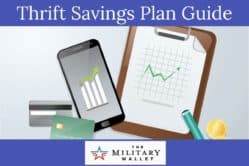Podcast: Play in new window | Download
Subscribe: Apple Podcasts | RSS
Table of Contents
- 2024 Thrift Savings Plan Contribution Limits
- Explanation of Thrift Savings Plan Contribution Limits
- Current and Historic Thrift Savings Plan Contribution Limits
- Types of Thrift Savings Plan Contributions
- Regular Contributions (Elective Deferral Contributions)
- Catch-Up Contributions
- Annual Addition Limit Contributions
- Two Thrift Savings Plans – Uniformed Services and Federal Service
- Uniformed Services TSP Contributions
- Catch-Up Contributions and Tax-Free Pay
- TSP Federal Agency Contributions
- Matching TSP Contributions Chart
- Contribution Limits With Multiple Retirement Accounts
The Internal Revenue Service released the 2024 Thrift Savings Plan contribution limits. The IRS calculates Thrift Savings Plan contribution limits annually based on the cost of living indexes.
The 2024 TSP contribution limits are set at $23,000 for elective deferrals, up from $22,500 in 2023.
The total maximum annual addition is $69,000 in 2024. If you’re over 50, you can make up to $7,500 in catch-up contributions, with a maximum yearly addition of $76,500.
2024 Thrift Savings Plan Contribution Limits
The 2024 TSP contribution limit for employee deferrals is $23,000, a roughly 2% increase from the $22,500 limit in 2023.
The IRS will continue its cap for catch-up contributions at $7,500 in 2024, the same as 2023. You can only make catch-up contributions if you’re at least 50 years old.
The IRS also issued a $3,000 increase in the 2024 total contribution limit, which includes employer contributions. If you’re under age 50, you and your employer can contribute $69,000 total to your TSP, 401k or other tax-advantaged retirement account. If you’re at least 50 years old, the total 2024 contribution limit is $76,500.
Here’s a breakdown of the 2024 Thrift Savings Plan contribution limits.
Elective Deferral Limit: $23,000
The elective deferral limit is the maximum amount that employees can defer from their paychecks to a Roth or traditional TSP account. Roth and traditional accounts share the $23,000 limit, so you can’t contribute the maximum to each.
To max out your TSP, you’ll need to contribute $1,916 per month from your paycheck, which may be too aggressive, depending on your pay grade.
How Much Can You Afford to Save?
Estimate With the 50/30/20 Budget Rule
Catch-up Contribution Limit: $7,500
Members aged 50 and over can contribute an additional $7,500 per year to their elective deferral limit ($30,500) and annual addition limit ($76,500). You’ll have to divert a little more than $2,540 each month to your TSP to max out your elective deferral and catch-up contribution limit.
Annual Addition Limit: $69,000
The annual addition limit encompasses contributions from all sources except catch-up contributions. It applies to elective deferrals, deployment contributions that exceed the $23,000 elective deferral limit and employer contributions, including Department of Defense matches through the blended retirement system.
Explanation of Thrift Savings Plan Contribution Limits

The following chart displays the 2024 Thrift Savings Plan contribution limits according to the Internal Revenue Code.
The combined maximum you can contribute – including employer contributions, contributions from special pay and bonuses and contributions while deployed, is $66,000 ($73,500 if you’re eligible for catch-up contributions).
| 2024 Thrift Savings Plan Limits | Maximum Contribution | Internal Revenue Code | Notes |
|---|---|---|---|
| Elective Deferral Limit | $23,000 | IRC §402(g) | Applies to the combined total of traditional and Roth contributions. For members of the uniformed services, this limit encompasses contributions from taxable basic pay, incentive pay, special pay and bonus pay. However, it does not apply to traditional contributions from tax-exempt income earned in a combat zone. |
| Maximum Annual Addition Limit | $69,000 | IRC §415(c) | Applies to the total amount of all contributions (per employer) made on behalf of an employee in a calendar year. This limit includes employee contributions (tax-deferred, after-tax and tax-exempt), agency/service automatic (1%) contributions and matching contributions. For 415(c) purposes, working for multiple federal agencies or services in the same year is considered having one employer. |
| Catch-Up Contribution Limit | $7,500 | IRC §414(v) | The maximum amount of annual catch-up contributions for participants age 50 and older. Catch-up contributions are separate from elective deferral and annual addition limits imposed on regular employee contributions. |
Current and Historic Thrift Savings Plan Contribution Limits
| Year | Employee Contributions | Catch-Up Contributions (Age 50+) | Total Contribution Limit | Total Contribution Limit With Catch-Up |
|---|---|---|---|---|
| 2024 | $23,000 | $7,500 | $69,000 | $76,500 |
| 2023 | $22,500 | $7,500 | $66,000 | $73,500 |
| 2022 | $20,500 | $6,500 | $61,000 | $67,500 |
| 2021 | $19,500 | $6,500 | $58,000 | $64,500 |
| 2020 | $19,500 | $6,500 | $57,000 | $63,500 |
| 2019 | $19,000 | $6,000 | $56,000 | $62,000 |
| 2018 | $18,500 | $6,000 | $55,000 | $61,000 |
| 2017 | $18,000 | $6,000 | $54,000 | $60,000 |
| 2016 | $18,000 | $6,000 | $53,000 | $59,000 |
| 2015 | $18,000 | $6,000 | $53,000 | $59,000 |
| 2014 | $17,500 | $5,500 | $52,000 | $57,500 |
| 2013 | $17,500 | $5,500 | $51,000 | $56,500 |
| 2012 | $17,000 | $5,500 | $50,000 | $55,500 |
| 2001 | $16,500 | $5,500 | $49,000 | $54,500 |
| 2010 | $16,500 | $5,500 | $49,000 | $54,500 |
| 2009 | $16,500 | $5,500 | $49,000 | $54,500 |
| 2008 | $15,500 | $5,000 | $46,000 | $51,000 |
| 2007 | $15,500 | $5,000 | $46,000 | $51,000 |
Types of Thrift Savings Plan Contributions
There are three types of TSP contributions:
- Regular employee contributions (including automatic enrollment contributions)
- Catch-up contributions (for participants age 50 or older)
- Annual addition limit contributions
Regular Contributions (Elective Deferral Contributions)
Eligible TSP participants can begin making regular employee contributions at any time. These contributions — also known as elective-deferral contributions — come out of your basic pay.
Traditional contributions come out of your check before you pay taxes on them. You can pay taxes on Roth TSP contributions before you deposit them, allowing your money to grow tax-free over time.
Once you make your contribution election, it will remain in place until you elect to stop contributing, change your contribution amount, reach the contribution limit or take a Thrift Savings Plan financial hardship withdrawal.
Catch-Up Contributions
You can make catch-up contributions each calendar year if you’re at least 50 years old. They will automatically stop if you don’t elect to make a catch-up contribution each year.
You can make regular and catch-up contributions at the same time.
If you plan your contributions carefully, you can maximize both the $23,000 regular contribution and the $7,500 catch-up contribution during the last pay period of the year. This is much simpler than tracking when your regular TSP contributions will max out, stopping the regular contributions and then starting catch-up contributions.
In addition, if you are eligible to make catch-up contributions and you are deployed to a designated combat zone, you can only make Roth contributions from your tax-exempt pay.
Annual Addition Limit Contributions
Annual addition limit contributions include all contributions during the applicable calendar year: your elective deferrals as well as employer contributions.
The annual addition limit also applies to contributions above the annual elective deferral limit (contributions above $23,000 in 2024) made by service members who are deployed to a tax-exempt zone.
The Internal Revenue Code §415(c) states the annual addition limit is per employer. However, for 415(c) purposes, working for multiple federal agencies or services in the same year is the same as having one employer. This applies to members of the National Guard or reserves who also work for a federal agency.
Two Thrift Savings Plans – Uniformed Services and Federal Service
Remember, there are two separate Thrift Savings Plan accounts:
- One for military members
- One for federal government employees
Members can have both accounts if they serve in the National Guard or reserves while working in civil service. The two plans share the same annual contribution limits across both accounts. So, you must carefully calculate contributions to avoid over-contribution penalties.
Uniformed Services TSP Contributions
The Thrift Savings Plan is available to all military members, who can contribute any whole percentage of their basic pay, bonuses, special pay or incentive pay, as long as it doesn’t exceed the annual IRS limit on elective deferrals.
- Roth TSP Contributions for TSP members
Roth Thrift Savings Plan contributions are limited to the $23,000 elective deferral limit. All additional contributions toward the annual additions limit must go into a traditional TSP account, even if the contributions come from tax-exempt pay.
- Tax-free Combat-Zone Contributions
Military members serving in tax-free combat zones can contribute up to $69,000. This total includes regular deferred contributions, tax-exempt combat zone contributions, special pay and bonuses.
Catch-Up Contributions and Tax-Free Pay
Military members who receive tax-exempt pay while serving in an eligible combat zone must make catch-up contributions to a Roth TSP account.
TSP Federal Agency Contributions
Federal civil service members can also make traditional or Roth TSP contributions within the same contribution limit.
Matching TSP Contributions Chart
Military members only receive matching contributions in the blended retirement system (BRS), not the legacy high-3 pension plan. FERS employees are eligible for matching contributions from the government.
BRS participants receive an automatic 1% contribution from the federal government, then a 100% match for the first 3% they contribute, followed by an additional 0.5% match for the next 2% they contribute. The total maximum agency contribution is 5%.
Participants can contribute as high of a percentage of their salary as they wish, as long as they don’t exceed total contribution limits, including the catch-up limits allowed for those age 50 and above.
Contribution Limits With Multiple Retirement Accounts
The TSP is similar to a 401(k) plan, and they share the same annual contribution limit per person. You cannot contribute more than $23,000 ($30,500 with catch-up contributions) across both accounts in any given calendar year.
The TSP system will not allow you to contribute too much to the TSP. If you do, the TSP will refund you the difference and reject future contributions through the end of the calendar year. But the TSP doesn’t have insight into your other retirement accounts.
If you have more than one retirement account, track your contributions carefully.
Military TSP and Federal TSP
National Guard and reserve service members who serve as federal technicians may have a military TSP account and a civil service TSP account.
Service members with two TSP accounts can contribute to both in the same tax year. However, these accounts share the same total contribution limit.
You can only exceed the annual employee deferral limit when you deploy to a tax-exempt combat zone. At this point, you can contribute up to the annual addition limit. ($69,000; or $76,500 with catch-up contributions).
TSP and 401k (or Similar Civilian Retirement Account)
TSP and 401k plans share the same annual limit, but they’re not connected. So, your TSP can’t track your 401k contributions or vice versa, making it possible to overcontribute. Track your contributions carefully if you contribute to both accounts to ensure you don’t accidentally incur a penalty.




Comments:
About the comments on this site:
These responses are not provided or commissioned by the bank advertiser. Responses have not been reviewed, approved or otherwise endorsed by the bank advertiser. It is not the bank advertiser’s responsibility to ensure all posts and/or questions are answered.
Eric says
Ryan, for 2023 I have been contributing to both my DoD civilian and Uniformed service TSP accounts. I recently returned home from a tax free combat zone. While overseas, I took advantage of exceeding my combined TSP elective deferral limit of $22,500 (but less than $66,000). It’s my understanding that now that I am home, I can no longer continue to contribute to either TSP account since the total elective deferral has exceeded $22,500. Is that correct? Apologies if this was answered already in a separate comment. Thank you!
Ryan Guina says
Eric, This is a great question. The answer depends on the type of contributions you made while deployed.
The annual elective deferral limit (sometimes referred to as an employee contribution limit) applies across employer-sponsored retirement accounts (such as TSP and 401k). The same limit applies if you have more than one account. For example, the elective deferral limit is $22,500 in 2023. You can only contribute up to $22,500 across all accounts—whether the contributions occur in one account or multiple accounts.
However, an Annual Addition limit ($66,000 in 2023) allows members to contribute more than the elective deferral limit. Employer-matching, agency-matching, and tax-exempt contributions to the Traditional TSP in a tax-exempt zone count toward the Annual Addition limit but not the elective deferral contribution limit.
Only your Roth TSP contributions count toward the elective deferral limit when you are in a tax-exempt zone. All tax-exempt contributions to the Traditional TSP only count toward the Annual Addition Limit.
So, it’s possible to contribute substantially more than $22,500 in a tax-exempt zone and still have room in your annual elective deferral limit, provided a large portion of the contributions were tax-exempt contributions to the Traditional TSP. If that is the case, you may still be able to make elective deferral contributions upon your return.
When you return from the tax-exempt zone, all your employee contributions again count toward the annual elective deferral limit. Your ability to make contributions stops once you reach the annual contribution limit. Your agency matching contributions also stop when you reach the elective deferral limit because you only get matching contributions when you make contributions. So, it’s important to plan your contributions while deployed to ensure you can continue receiving matching contributions once you return from your deployment.
Here’s the kicker—the annual contribution limit applies across both accounts. Unfortunately, the DoD civilian and Uniformed Service TSP accounts don’t “talk” to each other. Each respective account won’t have an automatic method to stop contributions once you reach the maximum annual limit. This is something you will need to monitor. You must contact the TSP to reverse excess contributions if you exceed the annual contribution limit.
I hope this answers your question!
Liz says
Thank you SO much for organizing and publishing this information.
Well written for easy understanding. Greatly appreciate this!!!
Gail Hunter says
I am presently contributing 8% to my matching account. I would like to take this back down to the required 5% – How would I go about doing that and is there a penalty to do this?
Brittany Crocker says
Hey there! You can edit your TSP contributions in MyPay! Here’s a handy MyPay guide to help you out! https://themilitarywallet.com/mypay-les-guide/
James says
I read your article. Very interesting. What is the limit for contributions across both accounts if you are active-duty military with Traditional TSP and a separate ROTH IRA at an investment firm?
Thanks
Brittany Crocker says
Hey there! The 2022 Roth IRA contribution limit is $6,000 if you are under 50 or $7,000 if you’re over 50. TSP contributions are the same as for 401ks, etc, $20,500 in 2022. If you’ve got both the TSP and a 401k, the limit applies to the sum of you contributions to each account. IRAs have a separate contribution limit.
Randall says
Ryan-
I have a civilian employer 401k with 3% match as well as the TSP under BRS with 5% match from the ANG.
I am unclear about the limits on contributions I have among the two accounts.
My understanding is that I get $19.5k employee contribution across the two accounts with an additional $38.5k annual additional limit for a total of $58k per unrelated employer. My drilling ANG pay is not enough to max out the $19.5k annually but has the better 5% match. Therefore my thinking is to contribute as much of ANG pay as possible to TSP for the match and the remainder of the $19.5k limit to the civilian 401k.
Where most of my uncertainty lies is in the annual additional limit and the rules between the two unrelated employer accounts. Am I able to contribute $38k to each?
How can I maximize my retirement savings across the two accounts? What to do with multiple accounts? What strategies are there to utilize both?
Thank for your insight!
Brittany Crocker says
Hey Randall, the contribution limits apply to the sum total of contributions across both accounts. So you get $20,500 total of just your own contributions. Your employer contributions don’t count toward that limit though. The annual additional also limit applies to the sum total of employer contributions to both accounts. Ryan wrote a little bit about this here: https://themilitarywallet.com/retirement-plan-contribution-limits/